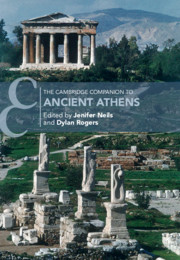Book contents
- The Cambridge Companion to Ancient Athens
- Cambridge Companions to the Ancient World
- The Cambridge Companion to Ancient Athens
- Copyright page
- Contents
- Contributors
- Abbreviations
- Athens: An Introduction
- 1 #Leagros: An Athenian Life
- Part I The Urban Fabric
- Part II Inhabitants
- Part III Business/Commerce
- Part IV Culture and Sport
- Part V Politics
- Reception
- 30 Roman Athens
- 31 Early Travelers and the Rediscovery of Athens
- 32 Modern Athens and Its Relationship with the Past
- 33 Urban Archaeology: Uncovering the Ancient City
- Index
- References
33 - Urban Archaeology: Uncovering the Ancient City
from Reception
Published online by Cambridge University Press: 10 March 2021
- The Cambridge Companion to Ancient Athens
- Cambridge Companions to the Ancient World
- The Cambridge Companion to Ancient Athens
- Copyright page
- Contents
- Contributors
- Abbreviations
- Athens: An Introduction
- 1 #Leagros: An Athenian Life
- Part I The Urban Fabric
- Part II Inhabitants
- Part III Business/Commerce
- Part IV Culture and Sport
- Part V Politics
- Reception
- 30 Roman Athens
- 31 Early Travelers and the Rediscovery of Athens
- 32 Modern Athens and Its Relationship with the Past
- 33 Urban Archaeology: Uncovering the Ancient City
- Index
- References
Summary
The large archaeological sites in Athens are the result of systematic excavations, while numerous rescue excavations following the pace of modern construction have revealed a wealth of information on all aspects of life in the ancient city. Although rescue excavations are conducted in a piecemeal fashion, they have provided fixed points in the topography of Athens, new finds, and identifications of monuments.
- Type
- Chapter
- Information
- The Cambridge Companion to Ancient Athens , pp. 462 - 481Publisher: Cambridge University PressPrint publication year: 2021
References
Further Reading
Petrakos has published extensively on the history of Greek archaeology, the contributions of individual prominent archaeologists, and the role of institutions, such as the Archaeological Society of Athens (e.g. Petrakos 2011, 2013). Hamilakis 2007, Bastéa 2000, and others discuss the role of antiquities in the construction of the Greek national narrative in a growing corpus of scholarship. On the early history of the foreign archaeological schools in Athens, see Whitling 2019. Archaeological reports of rescue excavations and new finds can be found in the annual volumes of the Archaiologikon Deltion and online (http://chronique.efa.gr). Judith Binder (1923–2013) had a deep knowledge of Athenian archaeology, especially the literary sources concerning the city. An avid opponent of Travlos, she challenged many of his identifications of ancient monuments. She has left two unpublished major resources on the study of Athens: The Monuments and Sites of Athens: A Sourcebook and The Monuments and Sites of Athens as They Were Seen, Described, and Investigated from 1102 to 1997, focusing on the history of excavations in the city. The most recent survey of the topography of ancient Athens can be found in the volumes of the Topografia di Atene by Greco (2010–2015).

